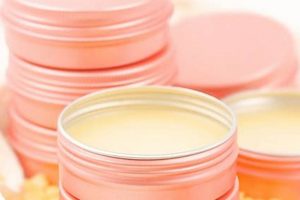The formulation of homemade remedies designed to alleviate canine pruritus encompasses a range of readily available ingredients and techniques. These solutions are intended to address discomfort associated with various dermatological conditions that manifest as scratching, licking, and biting in canines. An example would be preparing an oatmeal bath using finely ground oats to soothe irritated skin.
Implementing these strategies offers several potential advantages, including cost-effectiveness and control over ingredient composition, reducing exposure to potential allergens found in commercial products. Historically, pet owners have relied on home-based treatments to manage animal ailments, adapting traditional remedies for their companion animals as veterinary care evolved.
The following discussion will explore specific recipes and application methods, along with crucial considerations for ensuring the safety and efficacy of these interventions. It is imperative to understand when professional veterinary consultation is necessary to rule out underlying medical conditions requiring specialized treatment.
Tips for Addressing Canine Pruritus with Homemade Solutions
The following guidelines offer practical advice for creating and utilizing at-home treatments for managing canine itchiness. Strict adherence to established safety protocols and careful observation of the animal’s response are crucial for achieving positive outcomes.
Tip 1: Identify the Underlying Cause. Prior to initiating any home treatment, establish a possible cause. Allergies, parasites, or secondary infections often contribute to the condition. Veterinary consultation is recommended to rule out serious medical conditions.
Tip 2: Utilize Oatmeal Baths. Colloidal oatmeal possesses soothing properties. Grind plain, unflavored oatmeal into a fine powder. Add the powder to lukewarm water, ensuring it dissolves completely. Bathe the dog in the solution for 10-15 minutes, then rinse thoroughly.
Tip 3: Prepare a Chamomile Rinse. Chamomile tea contains anti-inflammatory compounds. Brew a strong chamomile tea, allow it to cool completely, and use it as a final rinse after bathing. Avoid getting it in the dog’s eyes.
Tip 4: Apply Coconut Oil Topically. Virgin coconut oil can moisturize the skin and reduce inflammation. Apply a thin layer of unrefined coconut oil to affected areas, ensuring it is fully absorbed. Monitor for any adverse reactions.
Tip 5: Incorporate Omega-3 Fatty Acids. Supplementing the dog’s diet with omega-3 fatty acids from fish oil can promote healthy skin and reduce inflammation. Consult with a veterinarian for appropriate dosage based on the dog’s weight and breed.
Tip 6: Maintain a Clean Environment. Regularly wash the dog’s bedding and toys to remove potential allergens and irritants. Use hypoallergenic laundry detergent and avoid fabric softeners.
Tip 7: Implement an Elimination Diet. Food allergies are a common cause of pruritus. Work with a veterinarian to introduce a novel protein source and carbohydrate source in a controlled manner, monitoring for symptom improvement.
Consistent application of these techniques, combined with close observation, can contribute to significant improvement in the animal’s comfort level. However, if symptoms persist or worsen, immediate veterinary intervention is required.
The information provided serves as a starting point for managing canine itchiness. The subsequent sections will address safety considerations and when to seek professional medical advice.
1. Ingredient Safety
The safe formulation of homemade remedies for canine pruritus hinges on meticulous selection and handling of constituent elements. Incorrect or uninformed choices can exacerbate dermatological issues or introduce novel health risks. Therefore, comprehensive understanding of ingredient properties and potential interactions is paramount.
- Toxicity Considerations
Many substances generally considered safe for human use are toxic to canines. Examples include certain essential oils, such as tea tree oil, which can cause neurological symptoms if ingested or absorbed through the skin. The inclusion of such ingredients in formulations represents a significant hazard.
- Allergenic Potential
Even seemingly benign substances can trigger allergic reactions in susceptible animals. Common allergens include certain grains, proteins, and plant extracts. Before applying any homemade remedy, assess the dog’s allergy history and conduct a patch test on a small area of skin to monitor for adverse reactions.
- Concentration and Dilution
The concentration of active ingredients is critical. Overly concentrated solutions can cause irritation or chemical burns, while excessively diluted solutions may be ineffective. Accurate measurement and appropriate dilution are essential. For instance, apple cider vinegar, often used as a rinse, should be significantly diluted to avoid skin irritation.
- Cross-Contamination Risks
Improper handling and storage can lead to cross-contamination of ingredients. Using contaminated water or storing ingredients in unsanitary containers can introduce bacteria or fungi, exacerbating existing skin conditions or leading to secondary infections. Strict hygiene practices during preparation are necessary.
These considerations underscore the critical role of ingredient safety in homemade pruritus remedies. While the intention may be to provide relief, unintentional harm can result from inadequate knowledge or carelessness. Careful research and, ideally, consultation with a veterinarian are strongly advised before implementing any DIY treatment regimen.
2. Underlying Cause
Addressing canine pruritus through homemade solutions necessitates a thorough understanding of the etiological factors contributing to the dermatological distress. Symptomatic relief, achieved through do-it-yourself methods, may offer temporary respite; however, long-term resolution depends on identifying and managing the precipitating cause. Ignoring this fundamental principle can lead to ineffective treatments and potential exacerbation of the underlying condition.
- Parasitic Infestations
Fleas, mites (e.g., scabies, Demodex), and lice are common ectoparasites that induce intense pruritus in canines. While certain homemade remedies, such as diluted neem oil solutions, may offer some repellent effect, they are often insufficient for complete eradication. Failure to eliminate the parasitic infestation results in persistent itching and potential secondary bacterial infections. Diagnostic tests, such as skin scrapings, are essential for identifying the specific parasite and guiding appropriate treatment strategies, often involving veterinary-prescribed medications.
- Allergic Dermatitis
Canine allergic dermatitis encompasses various forms, including flea allergy dermatitis (FAD), food allergies, and atopic dermatitis (environmental allergies). Homemade itch relief measures, such as oatmeal baths and coconut oil applications, can provide symptomatic relief by soothing irritated skin and reducing inflammation. However, these interventions do not address the underlying allergic trigger. Management of allergic dermatitis requires identifying and avoiding the allergen, which may involve dietary changes, environmental modifications, and, in some cases, immunotherapy prescribed by a veterinarian.
- Secondary Infections
Chronic scratching and licking, driven by pruritus, can compromise the skin barrier, predisposing canines to secondary bacterial or fungal infections. These infections often exacerbate the itching and create a cycle of self-trauma. While some homemade remedies possess mild antimicrobial properties (e.g., diluted apple cider vinegar), they are generally insufficient to resolve established infections. Veterinary intervention, including antibiotic or antifungal medications, is typically necessary to effectively treat secondary infections and break the itch-scratch cycle.
- Systemic Diseases
In some instances, pruritus may be a manifestation of an underlying systemic disease, such as hypothyroidism or Cushing’s disease. These conditions can alter skin physiology and increase susceptibility to infections, leading to itching. Homemade itch relief measures are unlikely to provide lasting relief in these cases. Addressing the underlying systemic disease is essential for resolving the pruritus and improving the canine’s overall health. Veterinary diagnostics, including blood tests and endocrine function tests, are crucial for identifying and managing these conditions.
The multifaceted connection between the underlying cause and the application of do-it-yourself itch relief underscores the importance of comprehensive assessment. While homemade remedies can offer adjunctive support, they should not be considered a substitute for veterinary diagnosis and treatment, particularly when the pruritus is severe, persistent, or accompanied by other systemic signs. The objective is to alleviate discomfort effectively and resolve the root cause, promoting long-term dermatological health in canines.
3. Application Method
The application method is a critical determinant in the efficacy and safety of homemade remedies for canine pruritus. The route of administration, concentration, frequency, and duration of application significantly influence the therapeutic outcome and the potential for adverse reactions. Inadequate attention to these details can render otherwise beneficial treatments ineffective or even harmful.
- Topical Application: Area and Technique
Topical application, involving direct contact of the remedy with the affected skin, is the most common method. The extent of the affected area dictates the quantity of the solution required. Proper technique, such as gentle patting or massaging the solution into the skin, ensures adequate absorption. Avoid vigorous rubbing, which can further irritate inflamed skin. For example, applying a diluted oatmeal paste to localized hot spots requires covering the entire affected area with a thin, even layer. Failure to adequately cover the area or using excessive force can diminish the soothing effect and potentially exacerbate the inflammation.
- Oral Administration: Dosage and Palatability
Oral administration, involving the ingestion of a remedy, is less common but may be applicable for certain supplements, such as omega-3 fatty acids. Accurate dosage is paramount to avoid toxicity or ineffectiveness. Palatability, the taste and texture of the remedy, influences the dog’s willingness to consume it. Mixing the remedy with palatable food or using a flavored vehicle can improve compliance. For example, incorporating a prescribed amount of fish oil into the dog’s daily meal can improve skin health. Inaccurate dosing or poor palatability can compromise the therapeutic benefits.
- Frequency and Duration: Treatment Schedule
The frequency and duration of application determine the overall exposure to the remedy. Frequent applications may be necessary for acute flare-ups, while less frequent maintenance applications can prevent recurrence. The duration of treatment should be tailored to the specific condition and the dog’s response. For example, an oatmeal bath may be administered daily during an acute allergic reaction, followed by weekly maintenance baths. Deviations from the recommended treatment schedule can compromise efficacy or increase the risk of adverse effects. Prolonged use of some topical treatments can lead to secondary skin infections or changes in skin microbiome.
- Vehicle Selection: Enhancing Absorption and Efficacy
The vehicle, the carrier substance in which the active ingredient is dissolved or suspended, can significantly affect absorption and efficacy. Aqueous vehicles (e.g., water-based solutions) are suitable for water-soluble ingredients, while oily vehicles (e.g., coconut oil) are better for lipid-soluble ingredients. The vehicle should be non-irritating and compatible with the dog’s skin type. For example, using coconut oil as a vehicle for applying essential oils can enhance absorption and moisturizing properties. Incompatible vehicle selection can reduce the efficacy or cause adverse reactions.
The relationship between application method and homemade itch relief emphasizes the need for careful consideration of several factors. Precise execution enhances safety, while also promoting better results. It is always wise to observe the animals response and adjust accordingly, or consult with a veterinarian if the methods are not improving their condition.
4. Monitoring Response
The process of observing a canine’s reaction to homemade treatments for pruritus is integral to the successful implementation of such interventions. This observation facilitates assessment of the treatment’s efficacy and identifies any adverse reactions that may necessitate a change in approach or veterinary consultation. The omission of consistent monitoring renders these treatments potentially hazardous due to the risk of undetected complications. Consider, for instance, the topical application of diluted apple cider vinegar. While intended to soothe, some canines may exhibit signs of increased irritation, redness, or discomfort following application, indicating an adverse reaction requiring immediate cessation of treatment. Such observations are central to responsible home care.
Continuous assessment of pruritus symptoms, such as scratching frequency, licking intensity, and the presence of skin lesions, provides a basis for evaluating treatment effectiveness. A decrease in scratching and licking, coupled with the healing of skin lesions, would suggest a positive response. Conversely, an increase in these symptoms or the development of new lesions signifies ineffectiveness or potential harm. Photographic documentation of the affected areas before, during, and after treatment can provide an objective means of tracking progress. If a homemade oatmeal bath fails to reduce itching after several applications, this indicates that the approach is ineffective and should be re-evaluated. Monitoring also serves to differentiate between true improvements and temporary symptom masking, thereby preventing the prolongation of inadequate treatments.
Effective home management of canine pruritus necessitates the active and informed participation of the owner in monitoring the animal’s response. This approach emphasizes the interplay between the chosen treatment and its effects on the canine, enabling timely adjustments. The insights derived from diligent monitoring contribute to the overall success of non-veterinary interventions, mitigating potential risks and promoting optimal outcomes. It is crucial to note that persistent or worsening symptoms despite home treatments warrant immediate veterinary attention to rule out serious underlying conditions.
5. Veterinary consultation
The application of homemade remedies for canine pruritus should not be viewed as a substitute for professional veterinary consultation. While certain at-home treatments may offer temporary symptomatic relief, veterinary examination is crucial for accurate diagnosis and identification of the underlying cause of the pruritus. Failure to seek veterinary guidance can result in delayed or inappropriate treatment, potentially leading to disease progression or complications. For example, persistent pruritus unresponsive to oatmeal baths and coconut oil applications may indicate a parasitic infestation requiring specific antiparasitic medication only available through a veterinarian.
Veterinary consultation enables comprehensive assessment, including physical examination, skin cytology, allergy testing, and other diagnostic procedures necessary to determine the etiology of the pruritus. A veterinarian can differentiate between allergic dermatitis, parasitic infections, secondary bacterial or fungal infections, and systemic diseases that may manifest as pruritus. This differential diagnosis is essential for selecting the most appropriate treatment strategy, which may include prescription medications, allergen avoidance, or management of underlying medical conditions. Employing homemade remedies without proper diagnosis can mask symptoms, delaying crucial interventions and potentially exacerbating the underlying disease process. For instance, using topical corticosteroids without addressing a concurrent bacterial skin infection can suppress the immune response, leading to further infection and complications.
In summary, the integration of veterinary consultation into any approach to canine pruritus, including the use of do-it-yourself solutions, is paramount. Veterinary expertise ensures accurate diagnosis, appropriate treatment selection, and monitoring for potential adverse effects. While homemade remedies may offer adjunctive symptomatic relief, they should be implemented under the guidance of a veterinarian to ensure the safety and well-being of the animal. The decision to pursue DIY itch relief should always be an informed one made in conjunction with professional veterinary advice, ensuring responsible and effective management of canine pruritus.
Frequently Asked Questions about DIY Itch Relief for Dogs
The subsequent section addresses common inquiries regarding the utilization of do-it-yourself interventions for managing pruritus in canines. Each question is answered with a focus on accuracy and safety considerations.
Question 1: Is it safe to use human anti-itch creams on dogs?
The use of human anti-itch creams on canines is generally discouraged. Many human formulations contain ingredients toxic to dogs, such as hydrocortisone and certain antihistamines, which can lead to adverse effects if ingested or absorbed through the skin. Additionally, human formulations may contain concentrations of active ingredients that are inappropriate for a dog’s size and physiology. Veterinary-specific anti-itch medications are generally safer and more effective.
Question 2: How can a dog’s scratching worsen even with homemade treatments?
Increased scratching despite homemade treatments may indicate that the underlying cause of the pruritus has not been adequately addressed. The itch could be driven by parasitic infestations, allergic reactions, or secondary infections that require veterinary intervention. Additionally, some homemade remedies may cause irritation in certain animals, exacerbating the condition. Re-evaluation of the diagnosis and treatment plan is essential.
Question 3: Are all essential oils safe for use in homemade dog itch relief remedies?
No, many essential oils are toxic to canines. Even diluted, certain essential oils can cause adverse reactions if ingested, inhaled, or absorbed through the skin. Tea tree oil, pennyroyal, and wintergreen are among those known to be harmful. The use of essential oils in homemade remedies should be approached with extreme caution and only under the guidance of a veterinarian experienced in aromatherapy for animals.
Question 4: Can diet alone resolve a dog’s itching problem?
Dietary changes can be effective in managing pruritus related to food allergies. However, diet alone may not resolve itching caused by other factors, such as environmental allergies, parasitic infestations, or secondary infections. Implementing an elimination diet under veterinary supervision can help identify and eliminate food allergens, potentially reducing or resolving pruritus in some cases. A complete resolution depends on addressing all contributing factors.
Question 5: What are the signs that a dog’s skin condition requires immediate veterinary attention, despite DIY efforts?
Signs indicating the need for immediate veterinary attention include severe or worsening pruritus, the presence of open wounds or oozing lesions, hair loss, fever, lethargy, or any other signs of systemic illness. These signs suggest that the condition is beyond the scope of home management and requires professional veterinary care.
Question 6: Is long-term use of homemade itch relief solutions safe for dogs?
The long-term safety of do-it-yourself interventions depends on the specific ingredients and the individual dog’s response. Prolonged use of some topical treatments may disrupt the skin’s natural microbiome or lead to irritation. Monitoring for adverse effects and periodic veterinary evaluations are recommended to ensure the continued safety and effectiveness of any long-term homemade treatment regimen.
In summary, homemade itch relief for canines may provide some relief, but a thorough understanding of ingredients, potential risks, and the underlying cause of the pruritus is essential. Veterinary consultation is always recommended to ensure safe and effective management.
The following section will address potential side effects and warning signs associated with the application of homemade treatments for canine pruritus.
DIY Itch Relief for Dogs
This examination of “diy itch relief for dogs” has traversed the landscape of homemade remedies, underscoring both potential benefits and inherent risks. The critical importance of accurate diagnosis, ingredient safety, appropriate application methods, and diligent monitoring has been consistently emphasized. Veterinary consultation emerges as an indispensable component of responsible canine care, ensuring informed decision-making and safeguarding animal well-being.
The information presented serves as a foundation for pet owners seeking to alleviate canine pruritus through non-veterinary means. However, it is paramount to acknowledge the limitations of these methods and to prioritize professional medical advice when symptoms persist or worsen. The future of canine dermatological care lies in the integration of evidence-based veterinary practices with informed and cautious implementation of supplemental home remedies, thereby promoting optimal health outcomes for companion animals.







